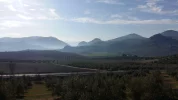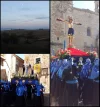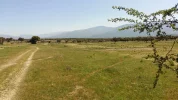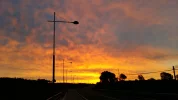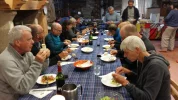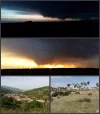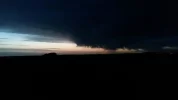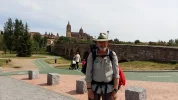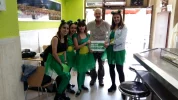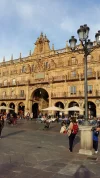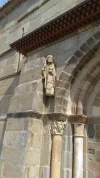The Way from San Pedro de Rozados was an easy gravel track and almost as soon as leaving, the lights of Morille could be seen in the distance, making route finding easy. In the village, I passed the well-known Bar de Isa which is renowned as one of the best for pinchos in the area, but it was closed so early in the day. As usual, the early morning scents of herbs and flowers were strong in the dewy verges, especially when passing some lilac, and it wasn't long, after a gentle climb through undulating pasture, that Salamanca could be seen on the horizon. The track pointed straight to it and several spires were visible, even at such long distance. About half way to Salamanca, the pueblo of Miranda de Azán lies a few hundred metres off the route and it has a bar that provided very welcome coffee and magdalenas, the sweet, light cakes traditionally "dunked" in coffee for breakfast. The downhill trail led straight into the city outskirts along a stream bed and through several housing estates of very colourful blocks of flats. Entering the city proper was via the Roman Bridge which gave directly onto the Casco Antiguo where there is treasure for historians and tourists alike. The city boasts two cathedrals, the older of which dates from the 12th century, the newer from 16th century and later. The latter was damaged in an earthquake in the 1700s and, at the time, a brave soul ascended to the very top of the cupola to check for damage and alignment. Annually now, and as part of a tradition, a student from the university climbs to that cupola each year in commemoration of the earthquake. Also of interest at the cathedral are several stone carvings from the 1990s, one of which is of a fully-suited spaceman. Salamanca is a most impressive city which could take weeks to discover, and there is a story or vista at almost every turn. Also of note were the tapas which were of highest quality and great value; no evening meal needed, as a result. The route out is easy to find and very direct, the one omission being yellow arrows or signs. It was only on the outskirts of the city that the first arrow was spotted and many pilgrims could be seen looking for signs in the city itself. In the village of Aldeaseca de Armuña there is a left turn which is easy to miss and thereafter the route is easy and well-signed. This is probably a day for contemplation and introspection, the route being easy but rather uninteresting as it follows a few undulations, parallels the highway, and passes Topas Penitentiary. It's crop-growing country, mostly given over to barley, some of which is now ripening, and some fields are ploughed, drilled and rolled with whatever is coming next. Canola is in evidence, its bright yellow flowers making an interesting contrast with the green barley and red earth. Remember to look behind, however, as the view is magnificent, with snow-covered mountains all across the southern horizon. It's surprising to think the Way has come past those mountains as it passed Aldeanueva del Camino and Puerto Bejár several days' hike ago. There are several albergues in the next village, Cubo del Vino, and FyM seemed ideal with extremely helpful owners who made everyone most welcome. The route to Zamora started in a very pleasant morning through the usual crops as massive irrigation systems watered the cereals and maize. It was a surprising discovery that the route would descend in one step from the high plateau into lower ground and that the views were as stunning as those of the Meseta after climbing out of Castrojeriz on
Camino Frances. The patchwork of green fields mixed with the predominantly red earth on the ridge created a feast of views which went clear to the horizon and made for a beautiful hike. The Way to Zamora is a gradual descent to the Douro river valley and the city can be seen for miles. The old city is particularly beautiful and is best seen from the route which follows the river bank to the new bridge. The remains of ancient bridge piles can be seen in the river and the views through the trees of the old city walls, the castle and the cathedral are exceptionally good. The municipal albergue is one of the best examples I've seen, housed in an ancient building but fully modernised to high standards and accomodated on three floors. It even has a sun deck. The city's history, like much of Spain, goes back to pre-Roman times and also includes important links to the Sephardic population of the middle ages and their subsequent "conversions" to catholicism. As in Salamanca, time is needed to explore all the city and its surroundings. Care is needed to route out of Zamora as the signs have recently changed. I ended up at a junction some miles out of town with yellow arrows pointing in completely opposite directions - so I followed those (to the east) which were generally towards Roales, and this worked. Another pilgrim went left and spent an hour being lost. Once established, the route is easy to follow, the one difference to my guide being the presence of the high speed railway which lies across the Way in many locations and which requires many small diversions. In fact, this new railway parallels the Way for many stages and is visible up to and beyond Asturianos. Having departed Zamora, the trail parallels the Ricobayo Reservoir as it heads north and then crosses the dried up river bed after Riego del Camino to head west for Tábara. This was a confusing stage because there are old and new Camino signs in coexistence after Montamarta, the latter in place to cater for the newly-built A66. Ignore the old or you'll do as I did and spend a pleasant hour walking around the reservoir and having to retrace your steps. Riego del Camino is quaint. It's very old, rather run down and has a municipal albergue which is adequate. However, there is another, private albergue in the village which would probably suit most people better, especially as it provides especially good food. The bar in the pueblo is interesting and unique, and provides limited food and drink, if you feel adventurous. Another dawn, another day, and it was 6km to breakfast in Granja at the local albergue. This place looked very modern and well-equipped, and certainly provided good coffee to start the day. Unlike the more routine previous day's hike, the route to Tábara was exceptionally beautiful and unique, first passing along a tree-covered ridgeline with expansive views to Sierra in the south, before heading down to the Rio Esla and a spectacular gorge. The hostalero at Riego had advised against following the gorge, and road signs, too, warned of danger on narrow trails and on the cliffs. Crossing the bridge across the river and turning immediately south, the trail was indeed rocky and narrow as it first descended almost to the water's edge then climbed on a rough goat track along the cliffs to the gorge itself. The alternative is a walk along the inland highway to Tábara but I found the cliffs and gorge far more interesting, the views from above the gorge being outstanding; the clifftops were an ideal place to enjoy the views. In any case, it can't be that bad because shortly after settling down to enjoy a snack and compliment myself on making the ascent, two cyclists appeared with bikes on their backs! The remainder of the route was a sedate affair with some "green-laneing" through rock-rose and encina, before arriving in open, crop-growing country that led first to Faramontanos de Tábara which, on first approach, looked like a frontier town in the Wild West. It was here that there is a collection of aging bodegas, all dug into the ground for keeping wine at constant temperature, and some are dilapidated while others remain in use. From there the Way passes across flat, water-irrigated plains to Tábara itself, hidden until the last minute by large plantations of maturing poplars. Entrance to the town is via a most imposing XII century church and then through its very picturesque Plaza Mayor. I stayed in the Parroquial Albergue at the far end of town and was most pleasantly surprised when the hostalero gave a comprehensive briefing for staying there and then proceeded to do all my washing! Service indeed. The meal was communal, prepared and served to a dozen of us by the hostalero himself, and the evening was rounded off by a recital of Spanish verse followed by a tasting of a few delicious local liqueurs. I slept well. The route out of Tábara was via the same old church but, heading north into the Sierra, it was necessary to negotiate a number of diversions due to the new railway. In retrospect, following the main road north until clear of the new railway, then rejoining the original route, would afford better views. Once on the Sierra, I elected to go to Santa Maria rather than Bercianos, and was rewarded by a most kind offer of breakfast in the local club at the Ayuntamiento. (There is no bar there.) Still heading north, the route climbs again and passes some more bodegas and vineyards before crossing through large tracts of neglected dehesa to arrive in the Vega Tera where it's waters are extracted to supply the water-thirsty crops of maize. Santa Croya is a very well-kept village but it's importance is overshadowed by the presence of Santa Marta de Tera (a short distance away) which has the oldest known statue of Santiago on its church walls, by the door. Turning west, the route will remain in this direction for a long way, following first the river valley and then remaining south of the Sanabrian Mountains before turning north for Santiago at Xunquiera. Along the river's left bank, the trail is a most pleasant meander through plantations of poplar and other woods of mixed pine and deciduous trees which all provide most welcome shade. At the river crossing en route is a recreation site called La Barca and this is an ideal place to take a dip in the river (which was very cold). I stopped later in Olleros de Tera where a local albergue provided excellent food in somewhat primitive accommodation. The next day was a trip back into Scotland, first climbing to cross the dam of the Agavanzal Reservoir before following its northern shore to breakfast at a small private Albergue in Villa de Farfón. Had I known it was there, I'd have tried to stay there the night before. The views across the reservoir in freezing temperatures were entirely in keeping with those at home, and the later crossing of heather and whin covered heathland bounded by high, pine-clad hills was straight out of Buchan'sThirty-nine Steps. Another reminder of Scotland was the unexpected appearance of light snow for the afternoon, so the likeness was complete. The route to Asturianos follows the valley, as do the power lines, two highways and the high speed railway line, but the views to the south are beautiful Sierra and there is a lot of wildlife there too. One peregrino reported seeing a wolf on this section but I had to make do with a glimpse of wild pig. Asturianos was full so the night was spent on the gym corridor floor with mattresses and very welcome blankets, the temperatures falling to below zero. Breakfast was in the bar at Palacios de Sanabria where the rustic bar had a roaring fire to help ward off the early morning frost. From there the route wound through oak woodland in a very low sun before emerging into real Highland with heather on the hills and the tops of the mountains covered in snow. I really had come home. Which was very fitting - because my Camino ended at this Puerta de Sanabria when my injured foot could no longer sustain the daily 30 and 40km. I will come back; one day; to finish the last few hundred km of this amazing journey which started all those weeks ago in Almeria. Every day has been even better the previous 24 hours, and every stage has provided an abundance of treasure. To all those who make the Mozàrabe possible, especially the Amigos, I thank you. To the countless individuals who have shown me kindness and tolerance and understanding, I thank you. To those who are thinking of Mozàrabe, I would strongly recommend doing it in Spring. To take from the Gautama Buddha, "It is better to travel well than to arrive" - and "There is no path to happiness - happiness IS the path". Above all, I thank my wife for her never-ending support, understanding and love; without her, none of this would have been possible.








